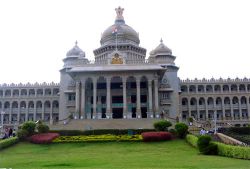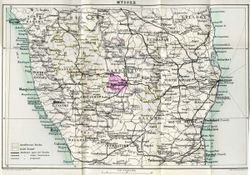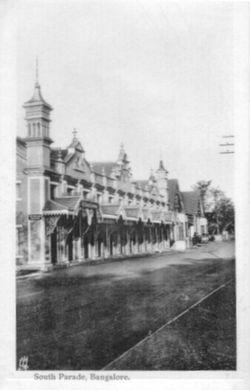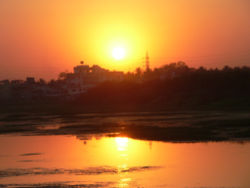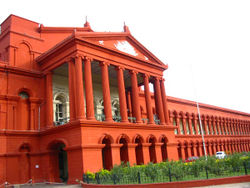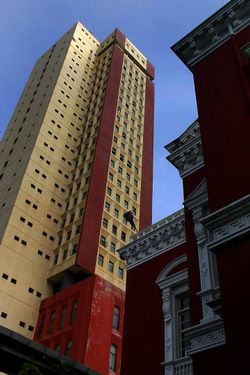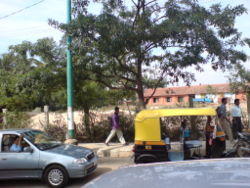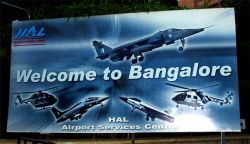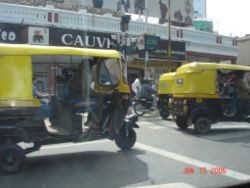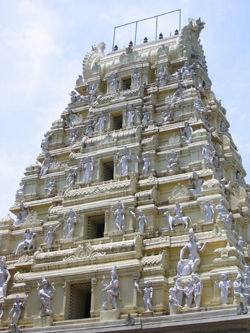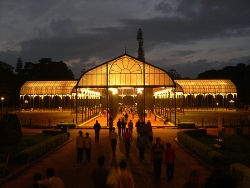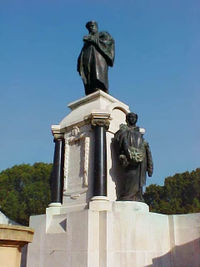Bangalore
2007 Schools Wikipedia Selection. Related subjects: Geography of Asia
| Bengalūru | |
| State - District(s) |
Karnataka - Bangalore Urban |
| Coordinates | |
| Area - Elevation |
476.66 km² - 920 m |
| Time zone | IST ( UTC+5:30) |
| Population ( 2006) - Density |
6,158,677 ( 5th) - 22,719/km² |
| Mayor | Mumtaz Begum |
| Codes - Postal - Telephone - Vehicle |
- 560 0xx - +080 - KA-01; KA-05; KA-41; KA-53 |
Bangalore or Bengalūru ( Kannada: ಬೆಂಗಳೂರು; pronunciation: ['beŋgəɭuːru] in Kannada and /'bæŋgəlɔː(ɹ)/ in English) is the capital of the Indian state of Karnataka. Located on the Mysore Plateau in south-western Karnataka, Bengaluru has an estimated metropolitan population of 6.1 million (2006), making it India's third-largest city and fifth-largest metropolitan area. Though historical references to the city predate 900 CE, a written history of continuous settlement exists only from 1537 CE, when Kempe Gowda I, whom many regard as the architect of modern Bengaluru, built a mud fort in the city and established it as a province of the Vijayanagara Empire.
During the British Raj, Bengaluru developed as a centre for colonial rule in South India. The establishment of the Bangalore Cantonment brought in large numbers of migrant Tamil, Telugu and North Indian workers for developing and maintaining the infrastructure of the cantonment.
After India gained independence in 1947 CE, Bengaluru evolved into a manufacturing hub for public sector heavy industries—particularly aerospace, space and defence. The establishment and success of business software services firms in Bengaluru after the liberalisation of India's economy has led to the growth of India's information technology industry. Bengaluru is referred to as the Silicon Valley of India and accounts for 35 percent of India's software exports. Home to prestigious colleges and research institutions, the city has the second-highest literacy rate among the metropolitan cities in the nation. However, as a large and growing metropolis in the developing world, Bengaluru continues to struggle with problems such as air pollution, traffic congestion, and crime.
On December 11, 2005, the Government of Karnataka announced that it had accepted the proposal by Jnanpith Award winner U. R. Ananthamurthy to rename Bangalore to its Kannada name, Bengalūru. On September 27, 2006, the Bangalore Mahanagara Palike (BMP) passed a resolution to implement the proposed name change, pending approvals from the Government of Karnataka and citizens of the city. On October 7th 2006, the Government of Karnataka accepted this resolution and decided to officially implement the name change on November 1st 2006. However, the name change still has to be approved by the central government, a process that is expected to take a few months.
Etymology
The name Bangalore is an anglicised version of the city's name in the Kannada language, Bengalūru. The earliest reference to the name "Bengalūru" was found in a 9th-century CE Ganga Dynasty stone inscription on a "veera kallu" (literally, "hero stone", a rock edict extolling the virtues of a warrior). In this inscription found in Begur, "Bengaluru" is referred to as a place in which a battle was fought in 890 CE. It states that the place was part of the Ganga kingdom and was known as "Bengaval-uru", the "City of Guards" in old Kannada. An article, published in The Hindu, states :
| An inscription, dating back to 890 CE, shows Bengaluru is over 1,000 years old. But it stands neglected at the Parvathi Nageshwara Temple in Begur near the city...(w)ritten in Hale Kannada (old Kannada) of the 9th Century CE, the epigraph refers to a Bengaluru war in 890 CE in which Buttanachetty, a servant of Nagatta, died. Though this has been recorded by historian R. Narasimhachar in his Epigraphia of Carnatica (Vol. 10 supplementary), no efforts have been made to preserve it. |
A popular anecdote (although one contradicted by historical evidence) recounts that the 11th-century CE Hoysala king Veera Ballala II, while on a hunting expedition, lost his way in the forest. Tired and hungry, he came across a poor old woman who served him boiled beans. The grateful king named the place "benda kaal-ooru" ( Kannada: ಬೆಂದ ಕಾಳು ಊರು) (literally, "town of boiled beans"), which was eventually colloquialised to "Bengalūru". There are also theories that the name has a floral origin and is derived from the tree Benga or "Ven-kai", also known as the Indian Kino Tree (Pterocarpus marsupium). The city as it is known today was named by Kempe Gowda I.
History
An inscription found near Begur, reveals that the district was a part of the Ganga Dynasty until 1004 CE and was known as Benga-val-oru, the "City of Guards" in old Kannada. The Cholas of Tamil Nadu ruled over the city from 1015 CE to 1116 CE until the town came under the rule of the Hoysala Empire. Modern Bangalore was founded by a feudatory of the Vijayanagara Empire, Kempe Gowda I, who built a mud fort in the proximity of modern Bengaluru in 1537 CE. Kempe Gowda referred to the new town as his "gandu bhoomi" or "Land of Heroes". Within the fort, the town was divided into petes ( IPA: [peɪteɪ]) or markets. The town had two main streets: Chickkapete Street ran east-west and Doddapete Street ran north-south. Their intersection formed Doddapete square — the heart of Bengaluru. Kempe Gowda's successor, Kempe Gowda II, built four famous towers that marked Bengaluru's boundary. During the Vijayanagara rule, Bengaluru was also referred to as "Devarāyanagara" and "Kalyānapura" ("Auspicious City").
After the fall of the Vijayanagara Empire, Bengaluru's rule changed hands several times. It was captured by the Maratha chief Shahaji Bhonsle prior to a Mughal invasion. The city became part of the Kingdom of Mysore when the Mughal emperor Aurangzeb leased Bangalore to Chikkadeva Raja Wodeyar in 1689 CE. After the death of Krishnaraja Wodeyar II in 1759 CE, Haider Ali, Commander-in-Chief of the Mysore Army, proclaimed himself the de-facto ruler of Mysore. The kingdom later passed on to Haider Ali's son Tippu Sultan, known as the Tiger of Mysore. Bengaluru was eventually incorporated into the British East Indian Empire after Tippu Sultan was defeated and killed in the Fourth Anglo-Mysore War (1799 CE). The British returned administrative control of the Bengaluru "pete" to the Maharaja of Mysore, choosing only to retain the Cantonment under their jurisdiction. Under British rule, Bengaluru was incorporated into the Madras Presidency. The Kingdom of Mysore relocated its capital from Mysore city to Bengaluru in 1831 CE. Two important developments during this period contributed to the rapid growth of the city — the introduction of telegraph connections and a rail connection to Madras in 1864 CE.
In the 19th century CE, Bengaluru essentially became a twin city, with the "pete", whose residents were predominantly Kannadigas, and the Bangalore Cantonment, whose residents were mostly migrants from Tamil Nadu. Bengaluru was hit by a plague epidemic in 1898 CE that dramatically reduced its population. New extensions in Malleswaram and Basavanagudi were developed in the North and South of the Pete. Telephone lines were laid to help co-ordinate anti-plague operations, and a health officer was appointed to the city in 1898 CE. In 1906 CE Bengaluru became the first city in India to have electricity, powered by the hydroelectric plant situated in Shivanasamudra. Bengaluru's reputation as the Garden City of India began in 1927 CE with the Silver Jubilee celebrations of the rule of Krishnaraja Wodeyar IV. Several projects such as the construction of parks, public buildings and hospitals were instituted to beautify the city. After Indian independence in August 1947 CE, Bangalore remained in the new Mysore State of which the Maharaja of Mysore was the Rajpramukh. Public sector employment and education provided opportunities for Kannadigas from the rest of the state to migrate to the city. Bengaluru experienced rapid growth in the decades 1941–51 CE and 1971–81 CE, which saw the arrival of many immigrants from northern Karnataka and Kodagu. By 1961 CE Bengaluru had become the sixth largest city in India, with a population of 1,207,000. In the decades that followed, Bengaluru's manufacturing base continued to expand with the establishment of private companies such as Motor Industries Company (MICO; a subsidiary of Robert Bosch GmbH), which set up its manufacturing plant in the city. Bengaluru experienced a boom in its real estate market in the 1980s and 1990s CE, spurred by capital investors from other parts of the country who converted Bengaluru's large plots and colonial bungalows to multistorey apartments. The establishment of multinational companies such as ANZ Bank and Citibank as well as international fast food chains such as Pizza Hut and Kentucky Fried Chicken (KFC) in the 1990s CE continued to expand foreign investment in Bengaluru. The city witnessed one of its largest media events ever when it hosted the 1996 CE the Miss World beauty pageant, which was seen by over two billion viewers worldwide. Many of these developments were met with opposition from groups fearing the loss of the city's national and linguistic identity. Widespread protests organised against the Miss World contest by women's organisations led to the arrests of about 1,000 protesters. In 1996 CE farmer activists attacked and damaged the KFC outlet in Bengaluru, accusing it of "representing western food habits which are not needed in India". Through the 1990s CE the state government promoted large-scale development projects such as the construction of sports stadia and exclusive apartment complexes, which resulted in the demolition and resettlement of poorer settlements to distant peripheral locations. In the mid-1990s CE, Bengaluru's economy grew many fold because of the software boom. Contrastingly, employment opportunities in almost all other sectors, in the city's manufacturing industries, declined. This was due to rampant and uncontrolled globalisation, liberalisation and privatisation.
Geography
Bengaluru is situated in the southeast of the South Indian state of Karnataka. It is located in the heart of the Mysore Plateau (a region of the larger Precambrian Deccan Plateau) at an average elevation of 920 m (3,018 feet). It is positioned at and covers an area of 2190 km² (1,360 mi²). Bengaluru District borders with Kolar District in the northeast, Tumkur District in the northwest, Mandya District in the southwest, Chamarajanagar District in the south and the neighbouring state of Tamil Nadu in the southeast. The Bengaluru Urban district is divided into three taluks: Bengaluru North, Bengaluru South and Anekal. The Bengaluru North taluk is a relatively more level plateau, while the Bengaluru South taluk has an uneven landscape with intermingling hills and valleys.
The topology of Bengaluru is flat except for a central ridge running NNE- SSW. The highest point is Doddabettahalli, which is 962 m (3,156 ft) and lies on this ridge. No major rivers run through the city, though the Arkavathi and South Pennar cross paths at the Nandi Hills, 60 km (37 mi) to the north. River Vrishabhavathi, a minor tributary of Arkavathi, arises within the city at Basavanagudi and flows through the city. Together, rivers Arkavathi and Vrishabhavathi carry much of Bengaluru's sewage. A sewerage system, constructed in 1922 CE, covers 215 km² (133 mi²) of the city and connects with five sewage treatment centers located in the periphery of Bengaluru.
In the 16th century CE, Kempe Gowda I constructed many lakes to meet the town's water requirements. The Kempamundi Kere, since overrun by modern development, was prominent. Later in the 20th century CE, the Nandi Hills waterworks, commissioned by Sir Mirza Ismail ( Dewan of Mysore, 1926–41 CE), provided adequate water supply to the growing city. Bengaluru currently relies heavily on water reservoirs from the Kaveri basin and on Vrishabhavathi and Arkavathi water treatment plants to meet the water needs of its population of six million. Bengaluru receives 800 million litres (211 million US gallons) of water a day, more than any other Indian city. However, water shortages, especially during summer, are commonplace. A random sampling study of the Air Quality Index (AQI) of twenty stations within the city indicated scores that ranged from 76 to 314, suggesting heavy to severe air pollution around areas of traffic concentration. For purposes of comparison, India's metropolitan cities Ahmedabad, Delhi and Kolkata were classified as having heavy pollution, while Bengaluru and Mumbai were categorised as having moderate pollution.
Bengaluru has a handful of freshwater lakes and water tanks, the largest of which are Madivala tank, Hebbal lake, Ulsoor lake and Sankey Tank. Groundwater occurs in silty to sandy layers of the alluvial sediments. Bengaluru receives adequate rainfall from the Northeast Monsoon as well as the Southwest Monsoon. The Peninsular Gneissic Complex (PGC) is the most dominant rock unit in the area and includes granites, gneisses and migmatites, while the soils of Bengaluru consist of red laterite and red, fine loamy to clayey soils. Vegetation in the city is primarily in the form of large deciduous canopy and minority coconut trees. Bengaluru has not been affected by major seismic activity due to it being located in a seismically stable zone (Zone II). Only mild tremors have been recorded in the city.
Because of its elevation, Bengaluru enjoys a pleasant and equable climate throughout the year. The highest temperature recorded is 39° C (102° F) and the lowest is 11°C (52°F). Winter temperatures rarely drop below 12°C (54°F), and summer temperatures seldom exceed 38°C (100°F). The wettest months are August, September and October, in that order. The summer heat is moderated by fairly frequent thunderstorms, and occasional squalls cause power outages and local flooding. Most of the rainfall occurs during in late afternoon, evening or night, and rain before noon is infrequent. The heaviest rainfall recorded in a 24-hour period is 180 mm (7 in) recorded on 1 October 1997 CE.
Civic administration
| Bangalore City officials | |
| Mayor | Mumtaz Begum |
| Municipal Commissioner | Kalaikurchi Jairaj |
| Police Commissioner | N Achuta Rao |
The Bengaluru Mahanagara Palike (BMP, Bengaluru Metropolitan Council) is the municipal corporation in charge of the civic and infrastructural assets of the city. The district of Bengaluru is home to 7 other city municipal councils such as those in Yelahanka, Bommanahalli, Dasarahalli, Krishnarajapuram, Pattangere, Bytarayanpura and Mahadevapura. The Government of Karnataka proposes to merge these 7 councils into BMP to form Greater Bengaluru. The BMP council comprises 100 elected representatives, called "corporators", one from each of the 100 wards (localities) of the city. Elections to the council are held once every five years, with results being decided by popular vote. A mayor and commissioner of the council are also elected through a quota system from a Scheduled Castes and Tribes candidate or to an Other Backward Class female candidate. Bangalore's rapid growth has created several problems relating to traffic congestion and infrastructural obsolescence that the Bengaluru Mahanagara Palike has found challenging to address. A 2003 Battelle Environmental Evaluation System (BEES) evaluation of Bengaluru's physical, biological and socioeconomic parameters indicated that Bengaluru's water quality, terrestrial and aquatic ecosystem were close to ideal, while the city's socioeconomic parameters ( traffic, quality of life) scored poorly. The BMP has been criticised by the Karnataka High Court, citizens and corporations for failing to effectively address the crumbling road and traffic infrastructure of Bengaluru. The unplanned nature of growth in the city resulted in massive traffic gridlocks that the municipality attempted to ease by constructing a flyover system and by imposing one-way traffic systems. Some of the flyovers and one-ways mitigated the traffic situation moderately but were unable to adequately address the disproportionate growth of city traffic . In 2005 CE both the Central Government and the State Government allocated considerable portions of their annual budgets to address Bengaluru's infrastructure. The Bengaluru Mahanagara Palike works with the Bengaluru Development Authority (BDA) and the Bengaluru Agenda Task Force (BATF) to design and implement civic projects. Bengaluru generates about 3,000 tonnes of solid waste per day, of which about 1,139 tonnes are collected and sent to composting units such as the Karnataka Composting Development Corporation. The remaining solid waste collected by the municipality is dumped in open spaces or on roadsides outside the city.
The Bengaluru City Police (BCP) is headed by a Police Commissioner, who is an Indian Police Service (IPS) officer. The BCP has six geographic zones, includes Traffic Police, City Armed Reserve, Central Crime Branch and City Crime Record Bureau and runs 86 police stations, including two all-women police stations. As capital of the state of Karnataka, Bengaluru houses important state government facilities such as the Karnataka High Court, the Vidhana Soudha (the home of the Karnataka state legislature) and Raj Bhavan. Bengaluru contributes two members to India's lower house of parliament, the Lok Sabha, and 24 members to the Karnataka State Assembly. Electricity in Bengaluru is regulated through the Karnataka Power Transmission Corporation Limited (KPTCL). Like many cities in India, Bengaluru experiences scheduled power cuts, especially over the summer, to allow electricity providers to meet the consumption demands of households as well as corporations.
Economy
Bengaluru's Rs. 222,000 crore ( USD 51.9 billion) economy (Net District Income) makes it a major economic centre in India. Indeed, Bengaluru is India's fourth largest and fastest growing market. Bengaluru's per capita income of Rs. 2.9 lakh (US$ 6,460) is the highest for any Indian city. As of 2001 CE Bengaluru's share of Rs. 1660 crore (US$ 3.7 billion) in Foreign Direct Investment was the 3rd highest for an Indian city. In the 1940s industrial visionaries such as Sir Mirza Ismail and Sir Mokshagundam Visvesvaraya played an important role in the development of Bangalore's strong manufacturing and industrial base. Bengaluru is headquarters to several public manufacturing heavy industries such as Hindustan Aeronautics Limited (HAL), National Aerospace Laboratories (NAL), Bharat Heavy Electricals Limited (BHEL), Bharat Earth Movers Limited (BEML) and Hindustan Machine Tools (HMT). In June 1972 CE the Indian Space Research Organisation (ISRO) was established under the Department of Space and headquartered in the city. Bengaluru is called the "Silicon Valley of India" because of the large number of Information Technology companies located in the city which contribute 38% of India's Rs. 100,000 crore (US$ 22 billion) IT and software export market. Bengaluru's IT industry is divided into three main "clusters" — Software Technology Parks of India, Bengaluru ( STPI); International Technology Park Ltd. (ITPL); and Electronics City. Infosys and Wipro, India's 2nd and 3rd largest software companies, have largest campus in Electronics City. As headquarters to 38% of global SEI-CMM Level 5 Companies, Bengaluru's place in the global IT map is prominent. The growth of Information Technology has presented the city with unique challenges. Ideological clashes between the city's IT moguls, who demand an addressal of the infrastructural problems of the city, and the traditionally bureaucratic state governments, whose electoral base is primarily rural Karnataka's agricultural workers, are aplenty. In July 2004 CE Wipro CEO Azim Premji threatened to pull his company out of the city, stating, "We do not see the situation (state of Bengaluru's infrastructure) improving in the near future". The Hosur Road, which connects Bengaluru to the Electronics City, is a heavily congested road in the city. The road is also part of the National Highway (NH7) and therefore witnesses heavy truck traffic as well. Biotechnology is a rapidly expanding field in the city. Bengaluru accounts for 47% or 127 of the approximately 265 biotechnology companies in India. Biocon, headquartered in Bengaluru, is the nation's leading biotechnology company and ranks 16th in the world in revenues. The Bangalore Stock Exchange is the largest in South India.
Transport
Bangalore's HAL Airport ( IATA code: BLR) is India's third busiest and functions as both a domestic and international airport. Direct flights from Bangalore fly to destinations in Asia, the Middle East and Europe. The liberalisation of India's economic policies has led to increase in the number of domestic carriers within India, with several low-cost carriers such as SpiceJet, Kingfisher Airlines, Jet Airways and Go Air servicing the city. Air Deccan, with its hub in Bangalore, has the most number of flights into and out of Bangalore. Unlike most airports in the country which are controlled by the Airports Authority of India, the quasi government-owned Hindustan Aeronautics Limited owns and operates Bangalore's HAL Airport, and also uses it to test and develop fighter aircraft for the Indian Air Force. The dual-vested interests in the airport along with an increase in air traffic to Bangalore led to a prolonged tussle for operational ownership between the HAL and the Government of Karnataka. In 1991 plans for a large-scale Bangalore International Airport were conceived; however, the project was repeatedly delayed due to red tape and friction between the private companies involved and the state government. Clearance for the construction of the US$ 288 million (Rs. 1,300 crore) airport was eventually granted in June 2004, with Siemens AG, Zürich Airport and Larsen and Toubro as its major private stakeholders. Construction work on the airport began in July 2005. This new International Airport is coming up in Devanahalli, 31 km North of Bangalore, and is likely to be operational by mid 2008. Also, the construction of the 6-lane Bangalore-Devanahalli expressway is underway, and most parts are nearly complete.
Bangalore is well connected to the rest of the country through the Indian Railways. The Rajdhani Express connects Bangalore to New Delhi. The city is also connected to Mumbai, Chennai, Kolkata, and Hyderabad, as well as other major cities in Karnataka. Three-wheeled, black and yellow auto-rickshaws, referred to as autos, are a popular form of transport. They are metered and can accommodate up to three passengers. Taxi service within Bangalore is provided by several operators commonly referred to as City Taxis and can take in up to four passengers and are usually metered and relatively more expensive than auto-rickshaws. Bangalore Metropolitan Transport Corporation (BMTC) operates a fleet of 3,207 BMTC public buses, servicing an average of 2,800,000 commuters. BMTC also has about 25 Low Floor, Air Conditioned Volvo buses on major routes and has plans to introduce another 25 by the end of 2006. The new additions to BMTC is its "Pink Buses" meant for the women passengers alone. An intra-city rapid rail transport system called the Namma Metro is being developed and is expected to be operational in 2008. The Metro, once ready, will encompass a 33 km (20.5 mi) elevated and underground rail network, with 32 stations in Phase I and more being added in Phase II.
Demographics
As of 2005 Bangalore had a population of over six million, making it the 3rd most populous city in India and the 27th largest city in the world by population. With a decadal growth rate of 38%, Bangalore was the fastest-growing Indian metropolis after New Delhi for the decade 1991–2001. Residents of Bangalore are referred to as Bangaloreans. While Kannadigas accounted for 38% of the population, sizable minorities from Tamil Nadu, Kerala, Andhra Pradesh and Maharashtra exist. Scheduled Castes and Tribes account for 14.3% of the city's population. Kannada, the official language of the state of Karnataka, is widely spoken in Bangalore, as are Tamil, Telugu,Tulu and Hindi. English is the lingua franca of the city's white-collar workforce.
According to the 2001 census of India, 79.37% of Bangalore's population is Hindu — roughly the same as the national average. Muslims comprise 13.37% of the population, which again is roughly the same as the national average, while Christians and Jains account for 5.79% and 1.05% of the population, respectively, double that of their national averages. Women make up 47.5% of Bangalore's population. Bangalore has the second highest literacy rate (83%) for an Indian metropolis, after Mumbai. The city's workforce structure is predominantly non-agrarian, with only 6% of Bangalore's workforce being engaged in agriculture-related activities. Roughly 10% of Bangalore's population lives in slums — a relatively low proportion when compared to other cities in the developing world such as Mumbai (54%) and Nairobi (60%). The 2004 National Crime Records Bureau statistics indicate that Bangalore accounts for 9.2% of the total crimes reported from 35 major cities in India. Delhi and Mumbai accounted for 15.7% and 9.5% respectively.. Communal tensions between the city's two largest ethnic groups, the Kannadigas and the Tamils, have led to numerous altercations. In early 1991, tensions between the two groups flared up with the proposed installation of a statue honouring the Tamil poet Thiruvalluvar in the city. Widespread agitation and protests organised by groups sympathetic to Kannadigas led the Commissioner of the Bangalore City Corporation to withdraw permission to unveil the statue, which remains wrapped under cloth. Later the same year, the Karnataka Government, acting upon the directives of the Government of India, agreed to release 205 tmc of water from the river Kaveri to the Government of Tamil Nadu, which resulted in anti-Tamil riots that left 20 people dead. After the demolition of the Babri Masjid in the North Indian city of Ayodhya in 1992, communal violence between Hindus and Muslims spread to Bangalore during which Muslim houses and huts as well as an Arabic school for Muslim girls were raided and torched. In 1997 the demolition of a stone structure in a mosque in Jayanagar led to violence in sensitive areas in the city that left four dead.
Culture
Bangalore is known as the Garden City of India because of its climate, greenery and the presence of many public parks, including the Lal Bagh and Cubbon Park. Deepavali, the "Festival of Lights", transcends demographic and religious lines and is celebrated with great vigour. Dussera, a traditional celebratory hallmark of the old Kingdom of Mysore, is another important festival. Other traditional Indian festivals such as Ganesh Chaturthi, Ugadi, Sankranthi, Eid ul-Fitr and Christmas are also celebrated. Bangalore is home to the Kannada film industry, which churns out about 80 movies each year in Kannada. Most Kannada movies are musicals, and their soundtracks are very popular in the city. The popularity of Kannada movies has spawned a new colloquial dialect, Bangalore Kannada, which draws upon youth culture and influences from English and other Indian languages. The diversity of cuisine available is reflective of the social and economic diversity of Bangalore. Roadside vendors, tea stalls, South Indian, North Indian, Chinese and Western fast food are all very popular in the city. Udupi restaurants are very popular and serve predominantly vegetarian, regional cuisine. Bangalore has many clubs and bars, and is sometimes referred to as the Pub Capital of India. Popular nightspots in Bangalore include HiNT, Taika, Pecos and TGIF. Bangalore is also a popular venue for Western rock concerts, with Mark Knopfler, Jethro Tull and The Rolling Stones, Joe Satriani, Bryan Adams, among others, having performed in the city.
Cricket is the most popular sport in Bangalore. A significant number of national cricketers have come from Bangalore, including current Indian cricket team captain Rahul Dravid, who lives in a big house in Indiranagar. Other cricketing greats from Bangalore are Gundappa Vishwanath, Anil Kumble, E.A.S. Prasanna, Venkatesh Prasad, Bhagwat Chandrasekhar, Syed Kirmani and Javagal Srinath. Many of the city's children play gully cricket on the roads and in city's many public fields. Bangalore's main international cricket stadium is the M. Chinnaswamy Stadium, which hosted its first match in 1974. Bangalore has a number of elite clubs, like the Bangalore Golf Club, Bowring Institute and the exclusive Bangalore Club, which counts among its previous members Winston Churchill and the Maharaja of Mysore.
Education
Schools in Bangalore are either run by the state government or by private, sometimes religious organizations. Private schools in Bangalore typically use English as the medium of instruction and are affiliated with either the Indian Certificate of Secondary Education (ICSE), the Central Board for Secondary Education (CBSE) or the Karnataka Secondary Education Examination Board. After completing their secondary education, students typically enroll in Junior College (also known as Pre-University) in one of three streams — Arts, Commerce or Science. Upon completing the required coursework, students enroll in general or professional degrees.
Sir Mokshagundam Visvesvaraya, Chief Engineer and later Diwan of Mysore (1912–19), played an instrumental role in shaping the early history of education in Bangalore. The University of Agricultural Sciences was started as a vocational school under his directives. He was also closely associated with the establishment of the Indian Institute of Science in 1909 and University Visvesvaraya College of Engineering ( UVCE) which was founded in 1917, UVCE is one of India's most prestigious engineering institutions. Rashtreeya Vidyalaya College of Engineering (popularly known as RVCE) is located on the outskirts of the city. Bangalore is home to several other nationally renowned universities such as the Indian Institute of Management Bangalore (IIM-B), National Law School of India University and Bangalore Medical College. St. John's Medical College and Bangalore Medical College are consistently ranked among the top ten medical schools in India. Bangalore's IT industry recruits extensively from the city's large pool of engineering colleges, notable among them are People's Education Society Institute of Technology, MS Ramaiah Institute of Technology , BMS College of Engineering and Sir M. Visvesvaraya Institute of Technology(Sir M.VIT) . The National Centre for Biological Sciences (NCBS), is one of the three places in India where Stem cell research is conducted. International Institute of Information Technology - Bangalore (IIIT-B) is a notable technology institute, that was started with a significant corporate participation in Electronic City.
Bangalore has a number of public libraries with free entry to all visitors. The oldest of the city's public libraries is located in the historical Sir Seshadri Iyer Memorial Hall in Cubbon Park.

